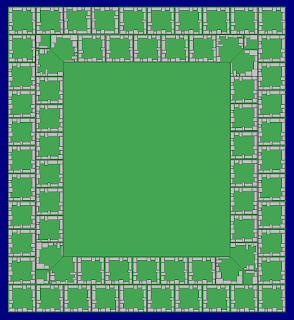This design also lends itself nicely to the creation of neighbourhoods.
The drawing once again is a simplified plan, there is nothing saying that the plder would be uniform in shape or lined up with military precision. The shape would in fact probably be dictated by the ground, with the outer polder following the shallower portions of the top of the seamount where possible.
Of course the seamount presents a finite amount of space, and while initially the design might follow that model, if successful there would no doubt be a push to reclaim the entire usable surface of the seamount.
H/T again to Steve for his contributions on another means.



More from Steve
ReplyDeleteI imagine it would end up being a round seamount top.... so what you'd actually see are a string of slightly curved polders (or perhaps keystone shaped) around the edge (I was only envisioning one layer of small polders), I am thinking you'd probably want somewhere between 2-5KM across depending of course on the size of the seamount. (I don't know what the minimum economically viable polder size would be.)
Within the polders the streets would probably form a grid--one axis pointing to the center of the sea mount, the other axis tangent to the shore in that polder; and at least two of the tangent streets should connect with ones in the next polder. So once the whole thing is done there will be two complete ring roads through the entire chain of polders.
Each polder would be a neighborhood, possibly with its own government office (even if it's just a police substation) or maybe we'd only need one every five polders.... Anyway, each polder would need at least two, preferably three independent pumping stations. You don't want one polder to drain into another even for purposes of pumping them dry. (Possibly the pumps can move from one polder to another as needed; I don't know much about how mobile they are. But whatever it is should handle both routine seepage and catastrophic flooding.)
Once the ring of outer polders is formed, the inner area can be pumped out and used--it would be a mega-polder, much larger than the rest (and politically might need to be subdivided to match the size of the others, depending on how the government ends up being organized). I can even envision creating a freshwater lake there (from rainfall or via desalination).
With regard to the size and shape of the polders I was thinking that rectangular would be better than square, in that for the same amount of material as a 1km square you could have a 1.5km long by 500m wide polder. 500m still gives a fair amount of interior space. I know it doesn't sound like much but the next time you are driving measure off 500m from a fixed point.
ReplyDeleteAs for what is an economically feasible size... I have no idea. I would imagine a straight sided polder would be easier to construct from a design point of view
The cost of a non-square polder would be a smaller area. The polder you describe would be 3/4 of a square kilometer; you've tossed away a quarter of your gain from the seawall.
ReplyDeleteActually the land I own is approximately a 400x400 meter square so I am pretty familiar with the scale--in essence four of my property would be a good approximation of 3/4 of a square klick.
I poked around and found the following figures: an acre can produce 1200 calories of meat or 6000 of grain or veggies, so figure about 3000 calories a day for a balanced diet. That's approximately 1 1/4 people eating 2400 calories a day A square kilometer has 100 hectares in it, or approximately 250 acres; so figure on a bit over 300 people. I'd reduce this back to 250 because not all of the land will be put to the plow; it will have houses, factories, mines, etc. on it. (This number is higher than I expected, BTW.) I've no doubt this number assumes highly efficient farming, using specialized equipment and fertilizer people there might not have available to them.
I was actually thinking hydroponic greenhouses with plants growing terraced over each other in PVC tubing (or something).
ReplyDeleteThere certainly has to be a better way to use farming space than 1 plant in the ground every 3 inches. :D
Oh, I forgot to mention that although the rectangular polder has less area within it, fewer of them are able to encapsulate a larger area than the square polders can.
ReplyDeleteAh, true. (For some reason my mental picture had them oriented the other way.) It might be long-term more efficient to do it that way. (An interesting ops-research optimization problem--of course to work it you'd have to be able to set a relative value on land being available earlier rather than later. Which we have implicitly assumed is true--If there were no value to earlier availability, one might as well simply build one ringwall enclosing the whole thing and be done with it.)
ReplyDeleteWhat might end up being the optimum mix is an initial circular or hexagonal polder (to lower the initial costs as much as possible, and get this area producing rapidly), followed by more and more rectangular polders to either side... then it's entirely possible the last quarter or so of the seamount would be taken care of with a single wall bridging the remaining gap, as the people there become impatient to use the huge land area. I wouldn't want that to happen. At the very least I'd want that second inner redundant wall built very shortly thereafter.
Oh... I have no ideas what method of agriculture was assumed in the figures I quoted. It may even have been greenouses and/or hydroponics. Hydroponics is *extremely* capital intensive though, and it may be the case that at first we do things conventionally, then as more and more people move in and it becomes Hong Kong in the middle of the ocean, real estate values make it desirable to convert old farms and necessary for new farms to be hydroponic/greenhouse.
ReplyDeleteAnother aspect we have to consider is that as the polders are drained there will be a tendency to have salt left behind. I don't know how big this effect will be. (It didn't happen to the Dutch in Flevoland becuase first they built their wall, allowing the salt water to be replaced with fresh by an inflowing river... then they drained. We won't have an inflowing river.)